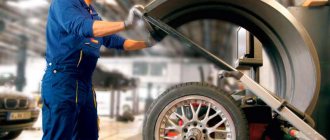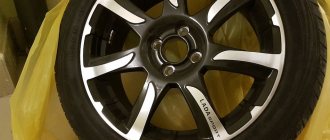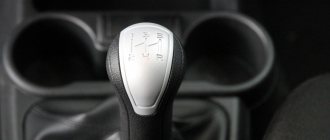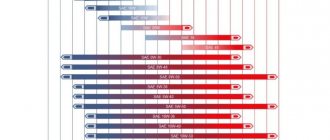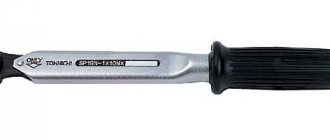Steps
Part 1
Car Lift
- Take a jack.
Your car comes with a jack so you can change one wheel at a time. But to swap all the wheels, you need to lift the entire car off the ground. The easiest and cheapest way to do this is to get a set of supports, which cost about $30. DO NOT attempt to do this with multiple jacks.
- If you don't want to buy supports, you can use cinder blocks. On the other hand, you can install a hydraulic lift in your garage that costs several thousand dollars.
- Find a surface with a suitable working level.
You can prevent the risk of a raised vehicle becoming unstable by working on a level surface. Apply the parking brake before starting work and block any wheels that you have not put on jack stands to prevent the machine from rolling forward or backward while you work.
- If the road is sloping or if there is no access road, you can spend very little time finding an empty space in the parking lot in front of the supermarket.
While your vehicle is still on the ground, use a Phillips wheel wrench and remove the hubcaps to get to the mounting bolts. Then, use a wrench to loosen the bolts that secure the wheel to the axle. DO NOT remove the bolts, just loosen them a little so that they come out easily when you lift the car.
- Remove one cap and use it as a container to store bolts.
Use a jack to raise each corner of the car, and then install the supports. Read the instructions to install them correctly.
- Using four legs is the easiest and fastest way to finish the job, but some people are rightfully nervous when the car is in the air. If you only have two jack stands, you will have to jack the car up and down several times because the procedure requires swapping the front and rear tires.
In any case, drawing up a rotation diagram before removing any wheels is a good idea.
Part 2
Rearranging Wheels
- Check the tread pattern on your tires.
Wheels can be directional or non-directional. Directional tires have a highly directional tread pattern, typically with grooves designed to channel water and sand outward to improve handling. For this reason, directional tires on the driver's side should not be swapped with tires on the passenger's side and vice versa. Omnidirectional tires look the same and it is perfectly safe to swap between driver side tires and passenger side tires.
- For directional tires, rotation means you need to swap the driver's side front wheel with the driver's rear wheel and vice versa.
For non-directional tires, under normal conditions, rotation means replacing the front driver's tire with the rear passenger's tire. The driver's side rear wheel replaces the passenger side front wheel, and both rear wheels move toward the front of the vehicle. With this option, you can be sure to perform a full tire rotation in two sets and ensure the longest possible tire life.
- Remove the mounting bolts from the first wheel you lifted and remove it.
Roll the wheel to a new location. Keep an eye on the bolts and keep them close to the axle from which they were removed. The threads should be the same, but in general their location should be tied to the car, not the wheel.
Rearrange the tires according to the correct pattern.
If you have the car fully jacked up, simply rearrange the wheels, place them on the hubs, and hand-tighten the mounting bolts.
- If you only have two mounts and they are both occupied, for example at the rear of the car, then you will start by removing the two rear wheels. Next, you will need to move the rear driver's wheel to the place of the front driver's wheel. Jack up the car a little on this side, remove the wheel, install a new one, tighten the bolts and lower the jack. Then move that front wheel to the rear of the car on the passenger side, and so on. Continue to move around the car, swapping wheels in the appropriate order (following the diagram).
- Lower the car.
Use a jack to raise each side of the vehicle until the jack stands can be safely removed, and then lower the vehicle. Before doing this, make sure that the wheels are securely secured. You should be able to rock the wheel back and forth.
- Tire rotation is a great opportunity to clean the rims, wheel arches, and also inspect the tires for hidden defects or punctures. Also, take the time to inspect the wheel arches and clear any debris from any brake cooling device.
Sequence of actions when replacing a wheel on a car
- Park the car, if possible, on a flat, horizontal area away from the roadway. If you have to stop on the side of the road near a traffic lane, be sure to turn on your hazard lights and set up an emergency stop sign.
- Apply the handbrake, set the manual transmission to first or reverse gear, and to “park” on the automatic transmission.
- Remove the jack (attached under the trunk floor on the spare wheel or in the rear fender niche), install it under the threshold near the damaged wheel, usually the location of the jack is marked by trimming the edge of the threshold. If the ground in the place where the jack is installed is soft, then place some hard surface from available means, for example, a piece of board, under its heel. Load the jack slightly without lifting the wheels, and orient it so that the jack stand is perpendicular to the sill of the car - this is important.
- Place blocks made from available material (bricks, stones, wooden blocks) under the diametrically opposite wheel on both sides to prevent the car from accidentally rolling.
- Take out the spare tire, it can be in the trunk under the floor, on the back door of the SUV, under the bottom of the crossover or in the engine compartment (like the Niva), and place it close to you.
- Without lifting the car, loosen the wheel nuts (bolts) with a wheel wrench. If the nuts do not unscrew (they are stuck), you can help with your foot using the long lever of a wheelbrace. Note: In the text of the article, the expression “nuts (bolts)” means that on different cars, wheels can be attached to the hubs in different ways - with nuts to studs or bolts to threaded holes. All threads securing the wheel to the hub are right-handed, that is, when unscrewing the wheel nuts (bolts), the key must be rotated counterclockwise, and when tightening, clockwise.
- Rotate the jack handle and lift the car until there is a gap between the wheel and the ground. Unscrew the loose nuts and remove the wheel. Attention! When performing operation step 7, try not to get your hands between the fender and the wheel, this can lead to serious injuries if the jack accidentally falls.
- Install the spare wheel onto the hub and hand-tighten the nuts (bolts) until they stop. Then tighten them with a wheel wrench according to the pattern “first - third”, “second - fourth” if there are four nuts on the wheel, or every other one in a circle if the number of fasteners is more than four.
- Lower the car until the wheel touches the ground and make the final tightening of the nuts (bolts) with a wheel wrench until they stop.
- Lower the wheel completely and remove the jack.
- Take out the pump or compressor, unscrew the nipple cap on the installed wheel, connect the hose to the nipple, turning the pump fitting flag 90°, check the pressure with a pressure gauge. Check the pressure in the same way on the opposite wheel; the pressure in both wheels should be the same. If there is a difference, bring the pressure in the wheels to the norm (the norm is indicated on the plate located on the driver's door pillar or on the back of the gas tank cap).
- After inflating the wheels, do not forget to screw the protective caps on the nipple, place the damaged wheel in place of the spare one, secure it, assemble all the tools, and do not forget the warning triangle.
The car is ready for the further journey, remove the chocks from under the wheel and go ahead.
Attention! If you have a spare wheel installed as a spare wheel, do not forget that the driving speed should be no more than 50 km/h, depending on road conditions, and you should only drive to the nearest service station or tire shop.
Warnings
- Many auto repair shops use a pneumatic device to loosen or tighten the bolts in your car. However, a very small percentage of these shops do not adhere to the recommendations when tightening the tips, and use more than 200 Nm. Excessively tightening the tips makes it extremely difficult for a person of average build and height to unscrew them.
- When changing a tire or rotating wheels, be sure to “lock” them to prevent any movement of the vehicle during the operation. To do this, you can use a medium-sized stone or a short wooden block (shoe) with a flat surface, placing it behind or in front of the opposite tire. (If you are changing the left rear wheel, you need to block the right front one, etc.)
Car tires may not wear evenly
: Front tires tend to wear out much faster than rear tires.
There are several reasons for this. So, most often the front axle of a car is loaded more heavily
than the rear (basically it accounts for about 60% of the car’s weight).
The front tires are subject to wear when maneuvering and also wear due to non-zero settings. In addition, the type of drive of the car is not least influenced: the drive axle causes the tires to wear out faster. By rotating (rearranging) the wheels, you can achieve more uniform wear and, as a result, extend their service life
.
There is another, no less obvious benefit from wheel rotation: tires with the same depth provide a higher level of comfort and safety.
. This is especially important when dealing with difficult weather conditions. So, for example, most.
How to rotate wheels correctly? It’s probably better to start from the type of tires installed on your car.
Scheme for rearranging wheels on a car
Details Category: Articles Published 05/07/2020
Today we will tell you how to rearrange the wheels on a car to ensure even wear.
Why is this even needed? The fact is that even in ideal conditions and with a fully functional car, the wheels of the car wear out unevenly.
For example, the rear wheels of a car only participate in acceleration and braking, while the front wheels also turn. Naturally, with each turn they experience increased friction and wear out more.
Wear also strongly depends on the type of vehicle drive - the tires on the drive wheels wear out faster than others, since they can slip during start-up and acceleration.
The front tires of a front-wheel drive car wear out especially badly - in this case, the front wheels are both driven and steered. In addition, the specificity of front-wheel drive is such that during a sharp start, the mass of the car is shifted backward by inertia, and the front axle is unloaded. Therefore, a front-wheel drive car can slip not only at the start, but also when driving in any gear - just press the gas sharply, especially in winter or on wet asphalt.
To level out uneven wear, since Soviet times it has been customary to periodically rearrange the wheels of a car, swapping them. If experienced drivers remember this, modern driving school graduates may not have heard of it.
It is advisable to rearrange the wheels every 8-10 thousand km. mileage For the average driver, this usually coincides with the seasonal “re-shoeing” of the wheels. Therefore, when replacing wheels with summer ones and vice versa, it is important to note the position of each wheel on the car so that the next time you change them, you can immediately rearrange them.
Let's talk about the most effective wheel rotation schemes that have been developed over many years of operation. They are different depending on the type of vehicle drive.
WHEEL REPLACEMENT DIAGRAM
Front-wheel drive
Taking into account the features described above, the scheme for rearranging wheels on a front-wheel drive car looks like this:
- We put the front wheels back;
- We put the rear wheels forward, changing places - left to right, right to left.
With this rearrangement, tire wear will be as uniform as possible.
Rear drive
The scheme for rearranging wheels on a rear-wheel drive car looks exactly the opposite:
- put the rear wheels forward;
- We put the front wheels back, changing places - left to right, right to left.
Four-wheel drive
The scheme for rearranging wheels on an all-wheel drive vehicle is even simpler - the wheels need to be rearranged diagonally;
- We swap the front left with the rear right;
- We swap the front right with the rear left.
Considering that all 4 wheels are driven, this scheme will minimize uneven tire wear while maintaining the balance of the vehicle's handling.
Tires with directional tread pattern
If you have tires with a directional tread pattern, you will not be able to move them from one side to the other. The fact is that such tires should only rotate in one direction, which is indicated by the arrow on the sidewall of the tire. By moving a wheel with such a tire to the other side of the car, we will change the direction of rotation to the opposite, which will worsen handling and only increase tire wear.
Therefore, if you have tires with a directional pattern, regardless of the type of vehicle drive, they can only be moved back and forth:
- the left front is swapped with the left rear;
- the right front is swapped with the right rear.
Asymmetrical non-directional tread pattern
The most popular type of tread on civilian tires at the moment is asymmetrical.
.
This, for example, is the case with most models of the MICHELIN summer line, ranging from economical to sporty. When installing asymmetrical tires on rims, it is necessary to align the front side of the tire with the front side of the rim
: for this purpose, the outside and inside inscriptions are present on the sidewalls (the outer and inner side of the tire) and there is no rotation direction arrow.
The convenience of this type of tread is that the wheel assembly can be changed between each other in any way: the outer side of the tire will remain external in any case
. In this case, it is appropriate to use any of the rotation methods. Usually the most suitable method for rearranging wheels is indicated in the car's operating instructions, but if you don't have one on hand, you can choose one of the methods we suggest.
Method 1
The front left wheel changes with the rear right one, and the front right wheel changes with the rear left one. This type of replacement is suitable for any type of vehicle drive and is most preferable for all-wheel drive vehicles.
Method 2
The rear wheels are moved to the front axle (the right rear wheel is placed in place of the right front one, the left rear wheel is placed in place of the left front one), while the front wheels are installed in place of the rear ones diagonally (the right front wheel is placed in place of the left rear one, the left front wheel is placed in place of the front axle). right rear seat). This method is suitable for cars with rear-wheel drive and all-wheel drive.
Method 3
The front wheels are installed in place of the rear ones (the right front wheel is in place of the right rear wheel, the left front wheel is in place of the left rear wheel), and the rear wheels, in turn, are moved diagonally to the front axle (the right rear wheel is placed in place of the left front wheel, the left rear - in place of the right front). This method is intended for cars with front-wheel drive.
Rearranging wheels
The treads of tires installed on the driven and driven axles of the car wear out at different rates. It is not difficult to guess that drive tires wear out much faster. To ensure even wear, manufacturers recommend swapping wheels instead of buying new wheels in pairs.
Most car enthusiasts use the simplest scheme - every 10 thousand km they move the rear wheels to the front axle, and install the front ones back. Advantages of the method:
- suitable for cars with front, rear and all-wheel drive;
- allows you to rotate tires with a directional pattern without turning over on the rims;
- relevant for cars with a spare wheel of the “dock” type.
The disadvantage of the scheme is that a full-fledged “spare” is excluded from circulation. Its tread remains high, which is why when installed as a result of a puncture, almost new rubber is subject to increased abrasion due to the action of the differential. To ensure that all 5 tires wear equally, use the following scheme:
- the right rear tire is placed forward on the same side, its place is taken by the “spare”;
- the right front wheel is moved back diagonally;
- The rear left wheel is installed on the front axle on the left side;
- the removed front ramp becomes a spare one.
Note. The replacement interval is 10 thousand km. This option is not suitable for tires with a directional pattern and cars with “rolling”.
To rearrange the wheels yourself in a garage, you need to get a strong stand - a block or a metal support. You will need to remove 2 slopes at a time, which cannot be accomplished with a single jack. The remaining wheels must be properly secured with shoes on both sides so that the machine does not move when lifted.
The replacement algorithm is simple: lift one side, remove the wheel and replace the block. Then move to another slope. Since at the time of lifting the support seat is occupied by the jack, fit the stand to one of the bottom stiffeners, or, in extreme cases, under the lower arm of the wheel being removed. It is better to loosen the fastening nuts of both disks in advance so as not to exert much force while hanging.
Rotation is useful for a number of reasons. If produced in accordance with the manufacturer's recommendations, tires provide better handling and more effective traction and wear more evenly. Other driving characteristics may be improved.
So when should you change your wheels? For performance tires, we recommend doing this every 5,000 to 8,000 kilometers, even if the tires show no signs of wear. It is convenient to perform the rotation simultaneously with an oil change, when the car is, one way or another, placed on a lift. If the wheels move evenly in a rotation pattern, all tires will wear equally.
Remember that rotation cannot affect wear caused by mechanical problems or incorrect tire pressure. It is also necessary to study the instructions to follow the scheme recommended by the manufacturer. The tires on the front axle work completely differently than on the rear. A front-wheel drive vehicle loads the tires differently than a rear-wheel drive vehicle. A sports car wears out its tires more than a family sedan. The location of each wheel determines its degree and type of wear.
Symmetrical directional tread pattern
Such tires are becoming less and less common in summer tire lines and are almost always winter tires: the V-shaped tread makes it possible to remove water from the contact patch as efficiently as possible. Thus, in the MICHELIN model range, CrossClimate summer tires and a number of winter tires (Latitude X-Ice 3, Alpin 5, etc.) have a directional tread pattern. Rotation with directional tires installed on the rims can be done in only one way: by swapping the front and rear wheels, i.e., the front left wheel in place of the rear left one, the front right wheel in place of the rear right one.
Rotating wheels using a spare wheel
This type of rotation allows you to extend the life of the wheels by approximately 20%.
, but in reality this method is almost never used: many modern cars either don’t have a spare tire in the trunk at all, or use a small-size spare tire as one. And even if your car is equipped with a full-size spare tire, in practice it most often differs either in the tire model or the type of wheel. However, if the spare wheel is completely identical to the wheels installed on the car, then rotation in this case can be extremely useful. For ease of wheel replacement, the tread pattern type should be either asymmetrical non-directional or symmetrical non-directional. The rotation process in this case is no longer as obvious as in previous methods.
Method 1
The front right wheel is removed in place of the spare wheel, the spare wheel is installed in the place of the rear right wheel, the rear right wheel is installed in the place of the front left wheel, the front left wheel is installed in the place of the rear left wheel, the rear left wheel is installed in the place of the front right wheel.
Method 2
The spare wheel is installed in the place of the rear right wheel, the rear right wheel is installed in the place of the front right wheel, the front right wheel is installed in the place of the rear left wheel, the rear left wheel is installed in the place of the front left wheel, and the front left wheel, in turn, is removed in place of the spare wheel.
How to change a tire: step-by-step instructions
The procedure can be divided into two stages - preparatory measures and the replacement itself. Let's get acquainted with the features of each of them.
Stage one. Preparatory activities
Before changing a tire, you need to do some preliminary preparation. It consists of performing several simple steps.
- First, turn off the car (if the incident happened on the road), and then put the parking brake on.
- Install an emergency sign, and do it correctly. So, if you stopped in an oncoming lane, then this sign should be located in front of the car at a distance of 15 meters, and if in your own lane, then also 15 meters, but already behind (within populated areas this distance should be 30 meters).
- Inspect the vehicle, install wheel chocks. Pay special attention to securing the wheel that is located diagonally in relation to the damaged one.
- Prepare all the necessary equipment in advance, as well as a spare tire.
After this, proceed to the main part of the work.
Stage two. Changing a wheel on a car
The algorithm of actions during replacement is given below.
- Check if the car is actually on the handbrake. You can additionally include first gear for the purpose of being on the safe side. If your car has an automatic transmission, then move the selector to the “parking” position.
- Next, under those wheels that do not need replacement, place pieces of bricks or special wedges that prevent them from rolling back. Moreover, you can even use ordinary blade-shaped logs for this. You have to drive them tightly under the wheels (it is recommended to use a hammer for this, thanks to which the wedges can be adjusted as deep as possible).
- After this, loosen the nuts of the damaged wheel. If you do this before you lift the car with a jack, the process itself will be easier and simpler.
- Prepare the spare tire in advance by placing it next to the vehicle. Never lean it against the body, otherwise it can easily roll, leaving deep scratches on it.
- Only then lift the car using a jack.
Note! Many inexperienced car owners make a mistake at this stage, which results in an inevitable visit to a car workshop. The upper part of the jack must rest against a specially designed socket at the bottom of the threshold - this will prevent serious damage and subsequent repairs.
- Use the jack until the entire damaged wheel is lifted off the ground.
- After raising the car, unscrew the nuts completely and remove the wheel itself completely.
- Take the new wheel and install it in place of the old one, securing it with the utmost care using the nuts. Here you must be careful and do not use too much force - this is explained by the fact that due to excessive zeal in tightening the car, you can easily push the car off the jack. As for the final tightening of the nuts, it is recommended to do it only after the machine is back on the ground.
- You are almost done replacing your damaged wheel. Now lower the car to the ground and finally tighten the nuts (in short, do what was recommended in the previous step).
- Place the removed wheel somewhere where it will not interfere with you (for example, in the trunk).
- Remove all wedges jammed there from under the wheels. Using a pressure gauge, check whether the tire pressure is correct and, if necessary, inflate it slightly.
- Pack all the tools and the emergency sign, after which you can safely continue your trip.
Note! Replacing a damaged wheel takes a maximum of ten minutes. Thanks to coordinated action, you can quickly resolve this issue and hit the road. If you don’t want/can’t do everything yourself, then leave the car and ask for help. In any case, there will be people who will help you.
Wheel rotation frequency
The more often you rotate the wheels, the more evenly the tires will wear.
.
But, since doing this too often is quite troublesome, experts advise changing the wheels during the periodic one - when the car is somehow lifted onto a lift. As a rule, a mileage of 8-10 thousand km
is quite enough for the next rotation of wheels: in this simple way you can not only
extend the life of the tires
, but also maintain the safety of movement at the proper level.
What car are you the owner of? — Front-wheel drive, rear-wheel drive or all-wheel drive. Do you understand the mechanisms of a car, do you understand how its power and maneuverability on the road are justified, especially during descents and ascents? Often, the operation of cars takes place on a whim, only a part of the owners with their vehicle are on a first-name basis. An experienced and attentive driver clearly understands which part needs to be replaced as planned, whether it is necessary to rearrange the wheels, and what diagram is suitable for this. Not everyone, for example, can afford to allocate up to 20-30,000 rubles from the family budget twice a year to purchase a set of winter and summer tires. In order to save money, car owners are looking for acceptable solutions to the situation. And there may be several of them.
There may be several ways out of the situation, but let’s pay attention to the simplest and most popular one - rearranging the wheels; the process diagram has never been complicated, and even more so, several variations are attributed to it. Choose practically without restrictions!
Service station employees recommend paying attention to the condition of the wheels, and if impressive numbers already appear on the dashboard indicating the mileage, and it is somewhere around 5,000-10,000 kilometers, then the rearrangement of the wheels is shown, the diagram is selected as desired. You should be extremely careful if you bought a used car second-hand, because then dashing craftsmen could twist the mileage figures, hiding the true wear and tear of the mechanical “stuff” of the car that was previously put up for sale. Then you should be guided by the condition of the tread pattern. We noticed wear on the front or rear wheels, assessed them as a percentage, and decided to rotate the tires according to the scheme. The following reasons for rearranging wheels are determined:
- Uneven tire wear.
- The need to strengthen one or another pair of wheels for front-wheel drive and rear-wheel drive vehicles, respectively.
- The desire to extend the life of tires, improve their condition by temporarily changing the load level.
- Unforeseen traffic situation, emergency repair work in the field.
Truck wheel rotation
On trucks, tire rotations should be performed every 40-50 thousand kilometers or when significant uneven tread wear is detected.
The following factors should be considered when planning reshuffles:
- what position is this particular tire model intended for;
- load on each individual vehicle axle;
- tread depth measurements for each tire.
In a standard three-axle trailer, the third axle is the most loaded, but the second one operates in the most gentle conditions. At certain intervals, you should measure the remaining tread depth and swap the least and most worn tires of the same functional purpose. Twin wheels should also be swapped periodically, especially if the difference in their residual depth is more than 3 mm.
When rotating non-directional tires, it is advisable to reverse the direction of their rotation.
Some manufacturers produce universal ones that can be installed on any axis. Such tires can first be placed on the steering position, and after some mileage they can be moved to the wheels of free-rolling axles.
Rotating the wheels will help you save on changing tires, because with even wear, the service life of one set increases significantly. In addition, the same tread height contributes to the stability of the vehicle's behavior while driving.
When independently changing the location of the wheels on a car, you must remember that the scheme for rearranging them depends on.
Why do you need to rotate wheels?
For every car, regardless of whether it is front-wheel drive, rear-wheel drive or all-wheel drive, the tires of the wheels located on the drive axle wear out more intensively than on the free one.
Ensuring uniform wear of their treads is possible only by periodically rotating the wheels of the car.
For most cars, this procedure is recommended to be performed every 10 thousand kilometers.
Ways to rotate wheels
For tires with a directional tread pattern, changing wheels is done by swapping the right front wheel with the right rear one, and the left front wheel with the left rear one.
As for all other wheels, some sources outline their rotation schemes separately for front-wheel drive, rear-wheel drive and all-wheel drive vehicle types.
It’s not clear why complicate something that can actually be done easily and simply?
Moreover, this method of rearranging wheels is universal and does not depend on the type of machine drive.
It is performed as follows:
1. The left front wheel is installed in place of the right rear;
2. The right front is installed in place of the left rear wheel;
3. The left rear wheel is installed in place of the left front;
4. Right rear - in place of the right front wheel.
However, this is exactly the case when it’s better to see it once...
Good luck to you! No nail, no rod!
A new set of tires can last 80 thousand kilometers or more, however, this applies to ideal working and road conditions. But we can create some of these conditions ourselves. Just a couple of simple rules, and the service life of tires can easily be extended by 30-40 thousand kilometers.
What you need to rotate your tires
There are tools in the trunk of any car, many of which are useful for repair work. The idea is to rearrange the wheels on a car, the diagram is supposed to be available, then the following available tools will be needed:
When undertaking such a painstaking procedure on your own, try to enlist the support of friends or family. There is no doubt that you will need support and help. When repairing a car, there is always something to support, serve, smoke, take out, move, substitute, and so on. The list of actions can be endless!
Rearranging wheels taking into account the spare wheel
If you include a spare wheel in rotation, you can achieve an increase in the wear threshold of the entire tire set by an average of 20%. But be careful and do not use the spare tire if it is in perfect condition and the four wheels are already bald. The reason is that there is a difference in radii, which can cause damage to the transmission.
Rearranging wheels on a car including a spare tire
Thus, it is not difficult to rotate the wheels; the main thing is to understand why this is necessary and how to perform this rotation procedure. Car enthusiasts claim that such routine actions will lead to results - an increase in the service life of tires.
All tires are divided into several types and types. During manufacture, tires are marked with a marking indicating its main parameters and characteristics. We will not delve into the markings, but we will look at the main differences. Tires are divided into two large groups according to the method of laying the cord inside the tire during its manufacture.
These are radial tires and bias-ply tires.
Tires of these two types can be winter, summer or all-season. Each of these three tires can have a regular or directional tread pattern. A tire with a regular pattern can be installed on either side of the car; a tire with a directional pattern can be installed strictly in the direction of rotation. Regular and directional tread patterns can be symmetrical or asymmetrical. A tire with such a pattern is installed according to the rule for tires with a regular or directional pattern.
It is possible to buy 4 identical tires and assemble them with rims in accordance with the right and left sides of the car. You will get two left wheels and two right ones. It is very rare to come across directional tires with an asymmetrical pattern and indicating the inner and outer sides. You need to buy two of these tires on each side. Two right and two left, but it’s better to avoid such tires altogether. They are not easy to use.
Rearrangement order
The rearrangement scheme may be different, but the correct way to do it is as follows: we put the rear tires forward in the same order as they were, that is, left to left, and right to right. The front tires should be placed crosswise on the rear axle, that is, we place the left front tire on the right rear side, and we do the same for the right front one.
But there is one significant nuance here - the asymmetrical pattern on the tread. If your tires are like this, then the rearrangement is done without changing the beads. On powerful or sporty cars, wheels of different sizes are often installed; in this case, the tires are swapped only along the sides, from right to left. And before each shift, carefully study the markings of your tires.
Tire rotation scheme
What car are you the owner of? — Front-wheel drive, rear-wheel drive or all-wheel drive. Do you understand the mechanisms of a car, do you understand how its power and maneuverability on the road are justified, especially during descents and ascents? Often, the operation of cars takes place on a whim, only a part of the owners with their vehicle are on a first-name basis. An experienced and attentive driver clearly understands which part needs to be replaced as planned, whether it is necessary to rearrange the wheels, and what diagram is suitable for this. Not everyone, for example, can afford to allocate up to 20-30,000 rubles from the family budget twice a year to purchase a set of winter and summer tires. In order to save money, car owners are looking for acceptable solutions to the situation. And there may be several of them.
There may be several ways out of the situation, but let’s pay attention to the simplest and most popular one - rearranging the wheels; the process diagram has never been complicated, and even more so, several variations are attributed to it. Choose practically without restrictions!
Service station employees recommend paying attention to the condition of the wheels, and if impressive numbers already appear on the dashboard indicating the mileage, and it is somewhere around 5,000-10,000 kilometers, then the rearrangement of the wheels is shown, the diagram is selected as desired. You should be extremely careful if you bought a used car second-hand, because then dashing craftsmen could twist the mileage figures, hiding the true wear and tear of the mechanical “stuff” of the car that was previously put up for sale. Then you should be guided by the condition of the tread pattern. We noticed wear on the front or rear wheels, assessed them as a percentage, and decided to rotate the tires according to the scheme. The following reasons for rearranging wheels are determined:
- Uneven tire wear.
- The need to strengthen one or another pair of wheels for front-wheel drive and rear-wheel drive vehicles, respectively.
- The desire to extend the life of tires, improve their condition by temporarily changing the load level.
- Unforeseen traffic situation, emergency repair work in the field.
Which tires are better
Based on the cord design, radial tires are preferable. Such tires are more reliable, they can withstand heavy loads when driving, and are more stable when deformed. Radial tires take longer to wear than bias-ply tires. Therefore, bias-ply tires are practically not produced at present. Almost all car owners have two sets of tires. For operating a car in winter, these are winter tires, for the summer, summer tires.
All-season tires can be used in both summer and winter. may be studded. Such tires are allowed only in a few countries where snow often and heavily falls in winter and ice forms on the road surface. Russia is also on this list. All-season, summer and winter tires have their own design characteristics that improve vehicle handling.
Front-wheel drive or rear-wheel drive vehicles can be equipped with tires with different patterns. Such tires are installed in pairs on one axle, for example, in front of the tire with one pattern, in the rear - with another. It is prohibited to install bias tires on one axle and radial tires on the other. The dimensions must be the same. All-wheel drive vehicles must have the same tires.
Tires with different treads and different sizes are strictly prohibited. This is due to the design of the transmission. If you drive a car with different tires, the car's transmission will quickly fail. In addition, driving on different tires becomes dangerous; a car will behave unpredictably on a slippery road.
Tire rotation rule
All car manufacturers and tire manufacturers recommend changing the tires on the car during operation. Why is this needed? During vehicle operation, all tires wear unevenly. This is due to several factors. Heterogeneity of the road surface, operating conditions and vehicle transmission design. Therefore, in order to extend the life of tires and car transmission, tires need to be rotated periodically.
On all-wheel drive vehicles, uniform tire wear is more important. Car manufacturers recommend several tire rotation schemes. But in practice, as often happens, it is impossible or impractical to use such tire rotation schemes. Many car owners never change their tires. Which of course is wrong.
How to rotate tires and how often should this be done? The frequency is approximately 8 - 12 thousand kilometers. Therefore, tire rotation can be timed to coincide with the replacement of tires from summer to winter and vice versa. Winter tires may be studded.
When using such tires, the studs tilt to one side. This occurs due to frequent wheel slipping.
Therefore, such tires must be installed in the direction of rotation as they were before. In this case, the tires from the front axle must be placed on the rear axle, and the tires from the rear axle must be placed on the front axle. In order not to get confused about which wheel was located where, in a tire workshop the technician usually puts a mark on the wheel. If you use one of the recommended schemes and, when installing the tires, change their direction of rotation to the opposite, the studs will begin to tilt in the other direction, their fastening in the tread will weaken and they will begin to fly out.
Which, of course, does not justify the advisability of rearranging the tires strictly according to the scheme. There is no point in this, the tires will wear out evenly, but almost all of the studs will fall out. If the tires are not studded, but have a directional pattern, the tires must also be rearranged, from the front axle to the rear, from the rear axle to the front, without changing the side of installation on the car.
If the tires do not have a direction of rotation, then it is possible to use a more complex scheme.
In this case, the rear tires are rearranged on the front axle in accordance with the sides. And the front tires are placed on the rear axle, but at the same time the right wheel is placed on the left, and the left wheel is placed on the right. There is another scheme for rearranging wheels. This scheme also involves a spare wheel. The spare wheel, of course, should be identical. When using this scheme, the tires wear out slightly longer during operation. In this case, the rear tires are moved to the front axle without changing sides, the spare tire is placed on the rear axle on the right, and the right front wheel is placed back on the left. The front left wheel becomes the spare wheel. But such a scheme can be applied if the car is equipped with non-studded tires and tires with a non-directional pattern.
If your car uses all-season tires, it is best to rotate them mid-season. That is, in summer and winter, and not during periods of changing seasons. Otherwise, it will turn out that one pair of wheels constantly “drives” on the snow in the front, and the other pair – in the summer on the asphalt on the rear axle. Again, wear will not be uniform. When using a rearrangement scheme without the participation of a spare tire, the latter does not wear out. There is a situation when you have to put a spare tire on a car and drive it.
The difference in tread height between worn tires and the spare tire negatively affects the vehicle's transmission. But you can still travel several tens of kilometers. It is advisable to drive as short a distance as possible using a spare tire.
It happens that a car owner has two sets of fully assembled wheels. That is, when replacing, you do not need to constantly bead the tires. All you need to do is change the wheels, for example, from winter to summer. Before replacing wheels, they must be balanced. This will also increase their service life, as well as the service life of the car suspension. Many car owners balance their wheels only when replacing tires with new ones and then drive them for the entire service life. It is not right. As tires wear, their point of imbalance changes. When a wheel slips, for example in deep snow, the weight on the disc may move. Therefore, it is necessary to periodically balance the wheels.
Rotating your tires is critical when it comes to extending the life of the tires you buy. As you drive under different driving conditions, your tires will wear unevenly. Depending on your driving style, it's wise to rotate your tires every 6,000 miles (9,700 km), roughly along with every other oil change. Read on to learn how to add this inexpensive and easy money-saving technique to your mechanic's arsenal.


